Learn all about video content marketing, with benefits, barriers, and real examples.
As a small business leader, you know how important it is to market your business as effectively as possible, and this may leave you wondering whether a video marketing campaign is worth the cost and effort.
Video marketing was once a luxury reserved only for companies with sufficient means. But with today's accessible technology, and with 75% of U.S. adults watching up to two hours of short-form video content each day[1], the need for utilizing video marketing is higher than ever. That's why every business should be using video content in their marketing strategy, even if that means starting small or outsourcing a service provider and scaling up.
In this article we’ll explain why, backed up by Gartner research.
Find providers that can help with your business needs by using our lists of video production companies by location.
What is video content marketing?
Video content marketing is a form of marketing that relies on video content to improve brand awareness, drive sales, and ultimately generate revenue. In other words, video content marketing serves the same purpose as traditional marketing (social media, email, print, etc.) but using video content as the format. (In the next section, we’ll look at why companies choose to use video content marketing).
Video content marketing can be done in-house using specialized video software that helps users create, edit, and publish video content. Businesses that don’t feel like they have the capacity to create video content in-house can contract these services out to a video production agency.
There are several different types of video content marketing, including but not limited to:
Animated videos
Demonstration videos
Instructional videos
Interview videos
Live stream or event videos
Testimonial videos
Why is video content marketing important?
There are many benefits to video content marketing, but they can mostly be summarized down to this: consumers want to see video content, and video content is engaging and effective.
Consider these statistics:
More than 75% of U.S. adults spent up to two hours watching short-form digital video content each day in 2021.[1]
44% of chief marketing officers are planning to increase investments in digital video advertising in 2023.[2]
83% of brand sites deploy video on at least one page on their website.[3]

In other words, the audience is already there, and your peers are likely already marketing to them using video. While that should be reason enough to make video content marketing an essential piece of your marketing strategy, there are even more benefits for marketing teams. Let’s take a look.
Benefits of video content marketing
In the previous section we looked at some statistics that show why marketers should use video content marketing. But just because you should do something doesn’t necessarily mean you want to do it (for example, eating healthy).
In this section we’ll look at some of the reasons that marketers will want to use video content marketing (i.e., the dessert).
You can target specific age groups and demographics with video content. The variety of video channels available makes it easy to choose one that best captures your target audience. For example, TikTok is a great platform to target a younger audience since 80% of TikTok users are between the ages of 16-34[4]. Targeting business leaders? You’re probably better off posting on LinkedIn. Facebook, Instagram, and YouTube also have mass appeal with a wide range of age groups. With so many channels available, it’s a good idea to test out your organic (non-paid) content on a variety of channels to see what resonates before expanding your campaign.
Video content marketing is easy to share. While your small business TikTok video probably won’t go viral, it’s likely to be shared by some viewers, and this will organically expand its reach. In fact, virtually all online video platforms include buttons that make it easy for users to share and amplify a video that they just viewed. Free amplification? This should be music to marketers’ ears.
Wondering what type of video content is most popular among marketers on TikTok? Our recent survey (methodology below) found that product or service demos (80%), videos featuring staff and employees (55%), and tours of company facilities (51%) were the three most popular choices for organic TikTok content.
Search engines favor websites with video content. If you want to boost your website’s SEO, simply add quality video. While the specifics of Google’s algorithm are carefully protected, it’s generally accepted that quality video content is seen by Google as a big positive. Want evidence? Just plug any search term into Google and see all the videos that appear in the search results.
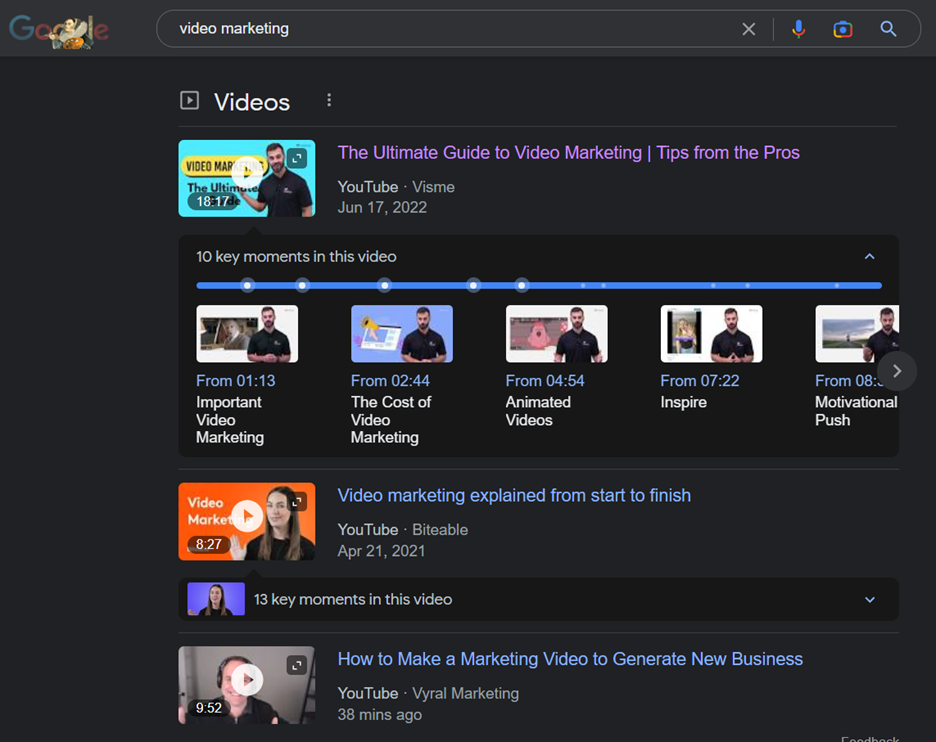
A Google search results page showing video results. (Source[5])
Video content improves brand awareness. According to a HubSpot survey[6], 36% of marketers report that the primary goal of their company’s video marketing efforts is to increase brand awareness. So why is video content so effective at improving brand awareness? By nature, video is just more engaging and memorable than other types of content. In your video content you can show the faces of your employees, introduce viewers to your brand in your own words, tell your story, and put your logo front and center.
Barriers to video content marketing
Hopefully by now you’re starting to think “we need to use video content marketing!” But you understandably might still have some hesitations. With that in mind, let’s look at some potential roadblocks to video content marketing along with responses to those obstacles.
We don’t have a video team to produce video content. The good news is that creating video content requires very few resources (which we’ll get to a little later on). In fact, all you need is a smartphone and someone to record with it. And if you do want some help with recording, editing, and producing—and you have the budget—you can outsource these tasks to a video production company.
Feeling uneasy about choosing the right video production company? Check out our hiring guide for help.
Our customers aren’t interested in video content. Yes, they are. Remember our statistic from above that 75% of all U.S. adults watch up to two hours of video content every day?
We don’t have the right equipment or budget. As mentioned above, all you need to get started with video content marketing is a smartphone. You can scale up as your program expands, but you already have everything you need to get started.
Our videos won’t get any views. While your video content might not make much of a splash in the beginning, the important thing is to get started and build consistency. After all, did you expect your business to bring in six figures of revenue on the day you opened?
Examples of video content marketing
Rather than continuing to read about video content marketing, you’re probably ready to see some examples of video content marketing in action.
Here are some examples of common types of video content marketing.
Demonstration videos
A demonstration video shows the viewer how a product or service works. Think of a demonstration video as an opportunity for the viewer to virtually try out a product without actually having to leave their home. For example, check out this product demonstration video from The Baby Cubby.
SNOO Smart Sleeper, The Baby Cubby (Source[7])
How you can make a demonstration video: Choose one of your most popular products, as these will likely generate the most interest. To earn trust and inspire confidence in the viewer, have one of your sales team members or someone else who knows the product inside and out demonstrate how it works.
Instructional videos
An instructional marketing video teaches the viewer how to do something related to a company’s products or services. For example, this video from outdoor brand REI shows how to use a compass, explaining the different parts and how to use them to navigate. Notice how the video doesn’t specifically promote a specific brand of compass by name. This helps build trust with the audience that the goal of the video is to help the viewer learn something rather than making a sale (although that may still be the end goal). Instructional videos also give you a natural opportunity to introduce more of your product line. For example, a video about using a compass presents a natural segue into videos about choosing the right hiking boots, how to properly pack a backpack, and how to safely wash a metal water bottle, for example.
How to Use a Compass, REI (Source[8])
How you can make an instructional video: While the REI video has slick production and sweeping visuals, all you need to make a good instructional video is your smartphone and someone knowledgeable about a topic relevant to your business. Try searching Google for terms relevant to your business and then checking the “People also ask” section of the results to get ideas for instructional videos.
Interview or testimonial videos
An interview or testimonial video is simply a video that uses an actual employee or customer as the subject. An employee can talk about what they do or what it’s like working for your company, while a customer might talk about their experience with your business (hopefully positive). For example, check out this testimonial about a combine harvester from a German farmer. These types of videos present a great opportunity to create an emotional connection with the audience. When viewers see real people in a video acting like real people, it creates a human-to-human connection.
MF Ideal | Testimonial, Massey Ferguson (Source[9])
How you can make an interview or testimonial video: If you have an employee who is especially comfortable in front of the camera, that’s a natural choice for an interview video. To source customer testimonials, check your reviews for customers that are especially happy with your business and reach out to them to participate in a video. You might even offer them a gift card in exchange for their time (just make sure to disclose that information in the video).
If you’re unsure of what type of video to start with, consider this statistic from Gartner: More than half of consumers (51%) want to see product functionality information the most, followed by product tutorials (43%).[10] The same report also found that consumers are less interested in videos on how to find or buy a specific product.
Resources needed to launch video content marketing efforts
As we mentioned above, all you really need to start creating content marketing videos is a smartphone. Really. It’s as simple as recording your video, trying to minimize the background noise, maybe adding some subtitles or a title card, and then uploading it to your YouTube business channel.[11]
As you scale up your video content marketing efforts, you can look into investing in a higher end camera, microphones, tripods, lighting equipment, video editing software… you get the idea. Outlining all of the equipment you might possibly want for an in-house video production team is a little too much to get into here, so if you’re interested check out this in-depth resource guide from Wistia.[12]
If that all seems like too much for your business to worry about, and you have the budget, consider outsourcing your video production to a service provider. Check out our directory of video production service providers to find companies that can do everything from planning to distribution and everything in between, including recording, editing, and marketing.
If you want to learn more about video production service providers, check out our guide to learn more about what type of services are available, the benefits of outsourcing vs. producing video in-house, and typical costs.
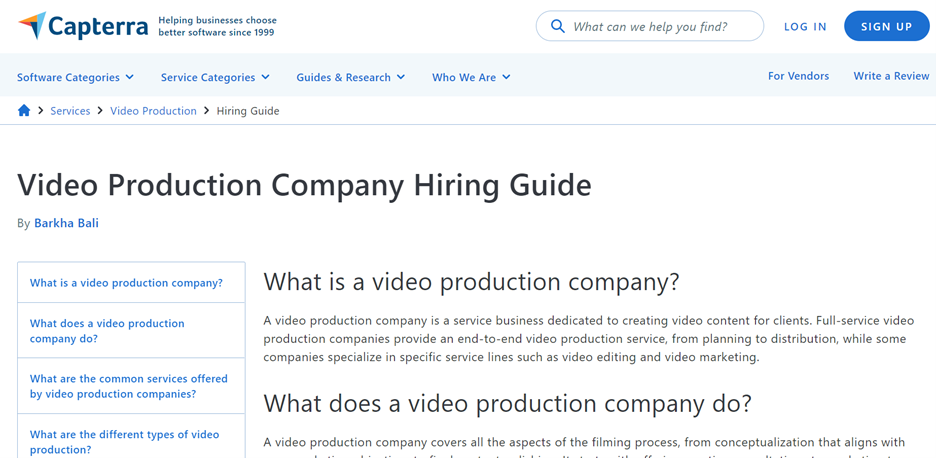
Capterra’s Video Production Company Hiring Guide (Source)
Tools for video content marketing
If you do decide to take the route of producing, editing, and distributing your own video content in-house, you’ll definitely want to use some type of video software. Video software is an umbrella category that includes everything from video editing to video marketing. Here are a few free video editing apps from our directory that are available for mobile devices. With free apps, it never hurts to try out a few and see which one works best for your business needs. You might even like one so much that you decide to upgrade to a paid version that offers additional features and capacity.
Here are a few key features of video software and how they can help your business:
Video editing. This feature enables businesses to edit their own videos and add things like text overlays, background graphics, soundtracks and audio, and more. This feature also allows users to cut and splice scenes together, sometimes with drag-and-drop functionality.
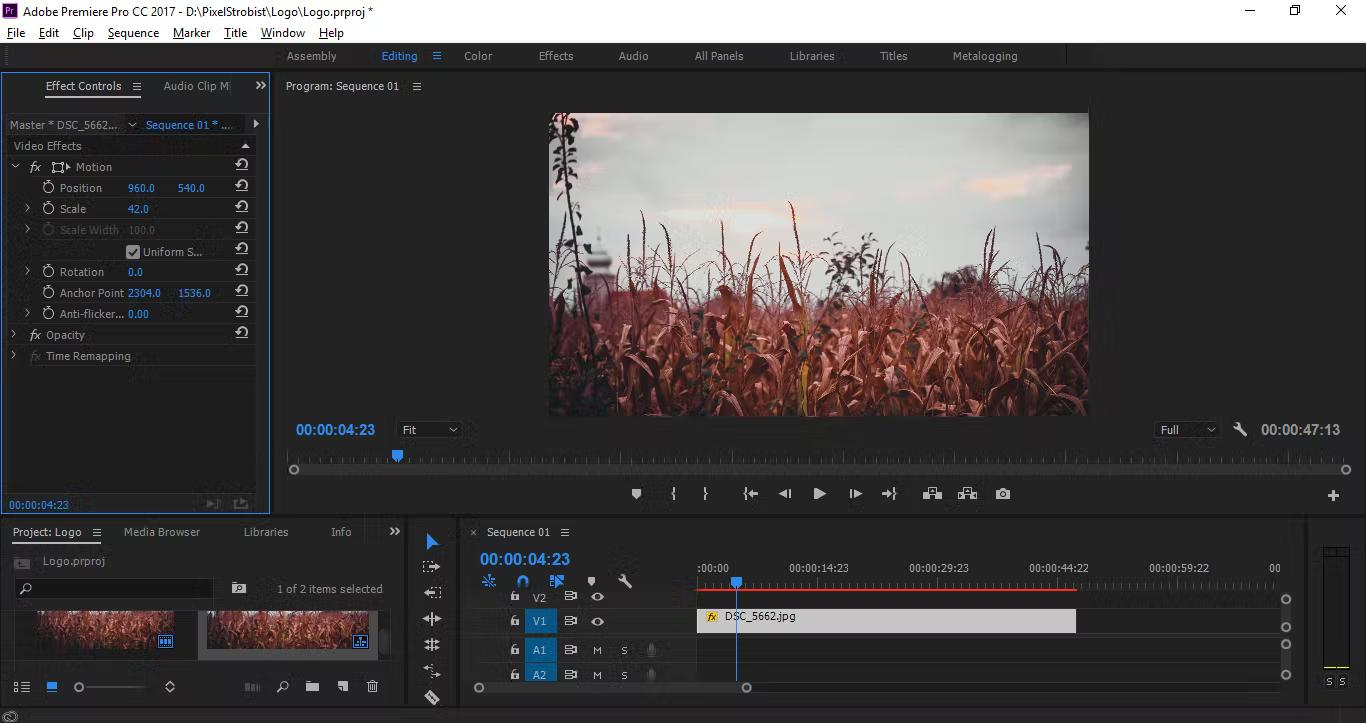
A video editing interface in Adobe Premiere Pro video editing software. The app is also available for mobile devices. (Source)
Templates. This feature allows users to create and save templates for commonly used video types. For example, a business that creates lots of product demonstration videos might want to save a template that includes a standard title card and background music.
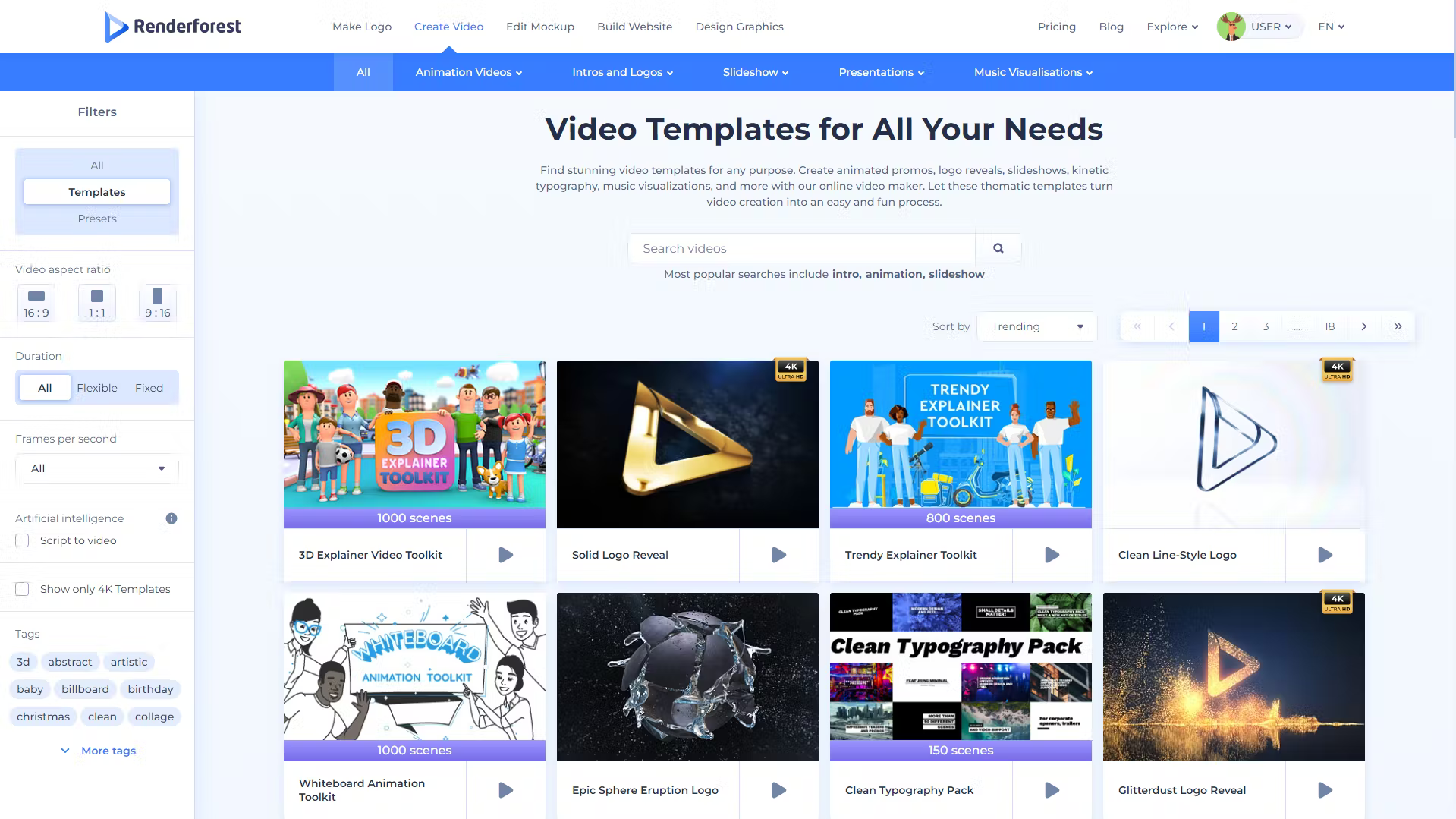
A menu of video templates in Renderforest video software, which is also available as a mobile app. (Source)
Social sharing. Your video software should include a feature that makes it easy to quickly distribute new videos to multiple social media channels (YouTube, Facebook, Instagram, etc.), and then track the performance of those videos.
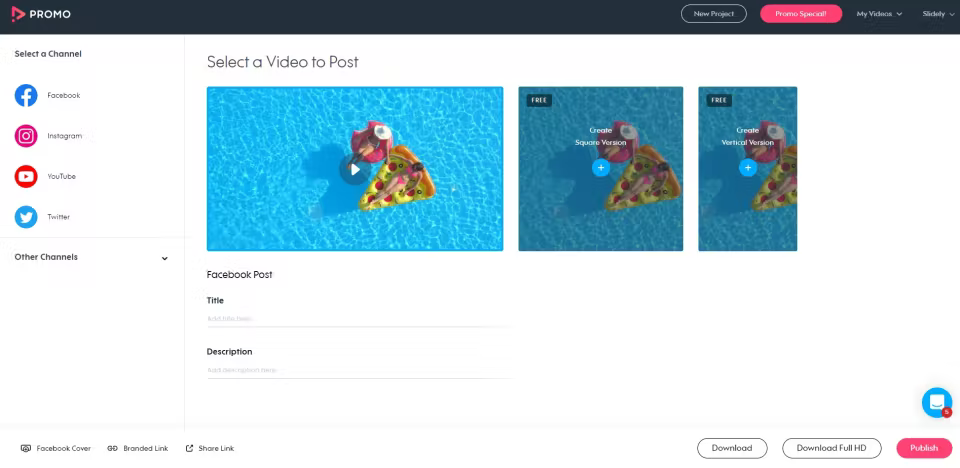
Sharing a video to Facebook using Promo.com video marketing software and mobile app. (Source)
Media library. Over time you’ll begin to gather lots of video clips, graphics, and sound files used for producing videos, and it’s helpful to have a digital library to store and organize all of those assets.

The media library tab in AVS video editing software. (Source)
Next steps for launching your video content marketing campaign
Now that you know all about video content marketing and how it can help your business grow, all that’s left is the fun part: making videos!
To summarize:
All you need to start is a smartphone.
Start with product tutorials and demonstration videos.
If your target audience is on the younger side, focus on posting to TikTok. If you’re going for more of a professional target audience, post your videos to LinkedIn.
If you have the budget and don’t care about getting hands on with your video production, consider outsourcing.
If you decide to produce your own videos in-house, you only need a smartphone to get started but you’ll eventually want to scale up to video software and other equipment.
Lastly, we’d like to leave you with our 2022 State of Marketing Tech Adoption report to help you learn more about how your fellow marketers are approaching technology.
